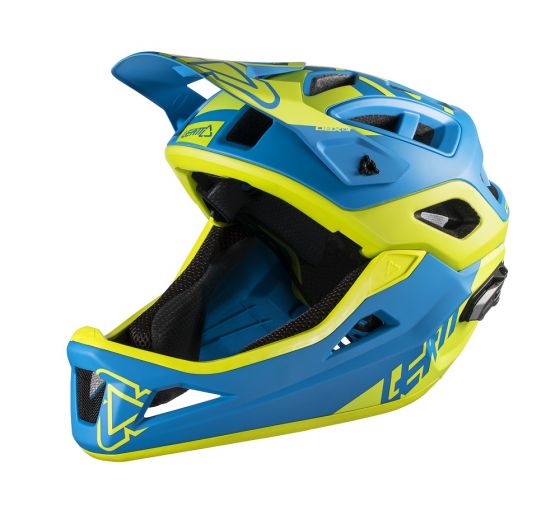
Leatt DBX 3.0 Enduro Helmet
Reviewer: 5’10”, 143 lbs; Head circumference: 56 cm
Size Tested: Medium
Blister’s Measured Weight: 413 g (without chinbar), 772 g (with chinbar)
Color: Blue/Lime
Stated Features:
- An enduro helmet with full-face option
- 360 Turbine Technology diffuses rotational energy
- In-mold construction helps dissipate impact force
- Removable chin bar when you don’t need it
- Breakaway visor reduces rotation in a crash
- 23 vents cool on warm days
Certifications:
- EN 1078
- CPSC 1203
MSRP: $240
Test Locations: Sedona, AZ; Northern & Southern CA; Coastal BC
Duration of Test: 4 months
Intro
While best known in the moto and DH world for their protective neck braces, Leatt has branched out by making pads, apparel, hydration packs, and helmets. One of their most recent offerings is the DBX 3.0 Enduro, a helmet with some unique features that prioritizes versatility first and foremost.
Similar to the Giro Switchblade and the Bell Super 3R, the DBX 3.0 Enduro can be converted between full-face and half-shell modes by removing its chin bar, making it a compelling option for those that want some added coverage but still pedal to access their descents.
Helmet Ratings and Technology
The category of Enduro helmets with removable chin bars is a relatively new one, so I think it’s worth briefly noting what different standards are out there, and which standards these helmets conform to.
The Leatt DBX 3.0 Enduro conforms to the EN 1078 and CPSC 1203 certification, which is the standard certification for half-shell helmets. This puts it roughly in the same category as the Bell Super 3R, which also appears a lot like like a traditional DH helmet when the chin bar is attached, but doesn’t meet the same safety certifications of a true DH lid. Because of this, I would be extremely hesitant to run the DBX 3.0 Enduro in a park riding or DH racing scenario.
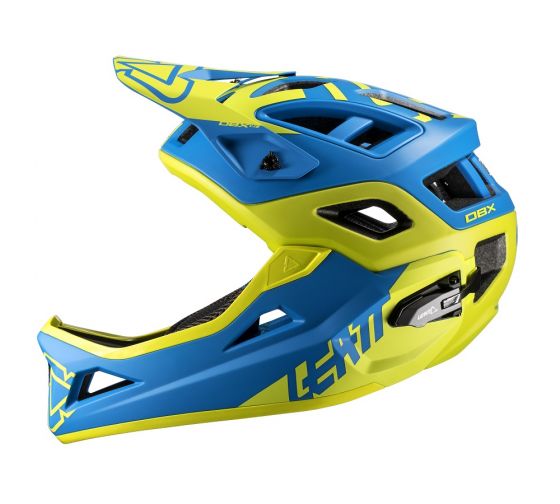
Official certifications aside, most mid-range to high-end helmets these days feature MIPS, a technology used to reduce the rotational forces on the brain that have been correlated with concussions. MIPS is essentially a plastic membrane that sits in between your head and your helmet that can break away from your helmet in an impact. So instead of your brain rotating inside your skull, the inner membrane rotates in relation to the helmet, theoretically preventing or lowering the severity of a concussion.
Leatt, on the other hand, uses their own proprietary 360 turbine technology, which is intended to reduce the same forces with a completely different design. Leatt’s “turbines” consist of rubber discs with spokes that connect to an anchor point in the center of the disc that in turn attaches to the foam of the helmet. In the event of a rotational impact, the disc will move with your head while the anchor point stays attached to the helmet. The spokes are intended to stretch to accommodate this movement, theoretically damping some of the force of the impact. Additionally, the disc itself is intended to damp directional impacts.
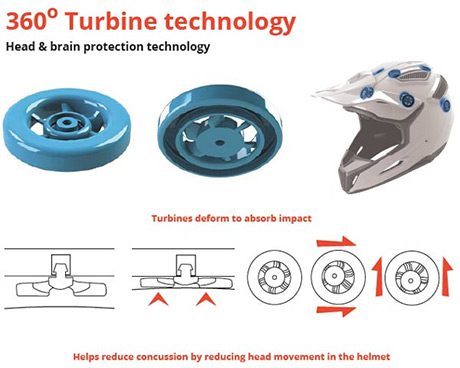
I’ll compare my own experience with MIPS and Leatt’s system later in this review, but since there isn’t a published standard associated with rotational impact reduction, I’m not going to make any bold statements about how Leatt’s technology affects concussion risk.
Design
The DBX 3.0 Enduro features most of the same features one would expect on a high-end mountain bike helmet. Ventilation is abundant, both on the body of the helmet and the chin bar. The chin bar also sits so that it’s easy to sneak in a hydration pack’s bite valve without removing the helmet – a good touch considering this helmet’s intended downhill and uphill use.
I also appreciate the magnetic clasp on the strap of this helmet. No, it’s not a brilliant engineering feat that improves safety or performance, but it’s a smart design that makes it a little quicker to take the helmet off.
The DBX 3.0 Enduro also features an adjustable breakaway visor, which Leatt claims can accommodate goggles when it’s flipped all the way up, although I was never able to do this comfortably.
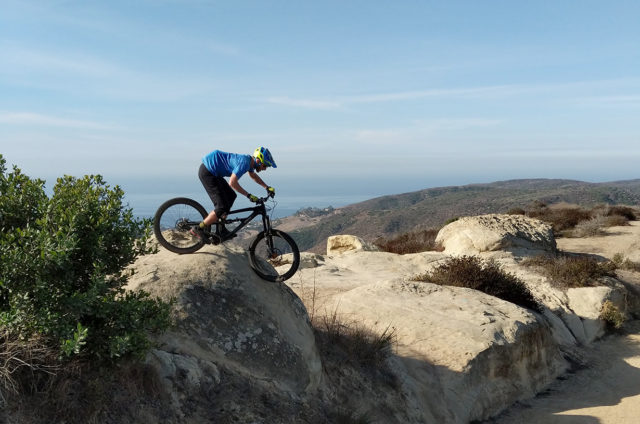
Taking the chin bar off is a simple affair that can just as easily be accomplished with the helmet on or off. Just undo the latches on each side of the helmet, and slide the chin bar out. This design is a light and simple approach, but Leatt manages to avoid making the latches feel too chintzy.
With the chin bar attached, the helmet doesn’t quite look like a true full-face, but at a glance it’s a pretty close approximation. There’s something confidence-inspiring about encasing yourself in a bulky DH helmet, and the DBX 3.0 Enduro doesn’t feel that way because of its venting and lesser coverage. This might make some folks hesitant to use it in scenarios where they could just as easily be wearing a true full-face, which is probably fine, given its intended use. This helmet only makes sense when it’s replacing a designated half-shell, not a DH helmet, since the DBX 3.0 Enduro does not meet DH helmet standards.
Fit
The DBX 3.0 Enduro is offered in sizes Small, Medium, and Large. As the sizing chart suggested, the Medium worked great for my 56 cm head. The helmet has a pretty standard dial fit adjustment system with a large range of adjustment, so in terms of sizing, I imagine pretty much everyone out there should be able to find a size that works for them.
Shape-wise, I’d be most inclined to compare the DBX 3.0 Enduro to the round-ish oval shape of most Smith helmets – the DBX 3.0 Enduro is definitely more rounded than most Giro helmets, but not quite as round as most helmets from Bell.
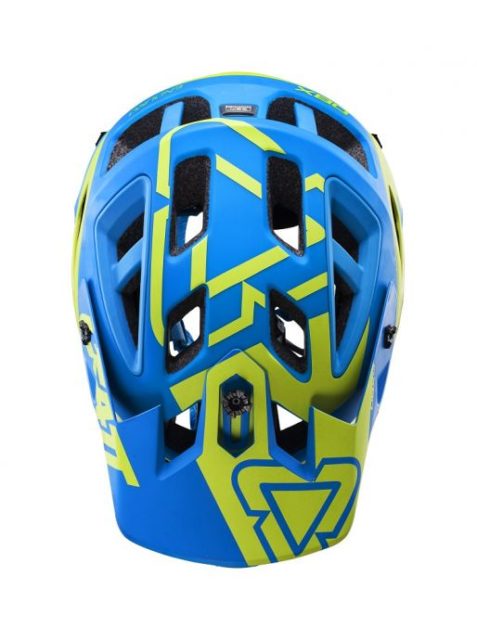
Performance
I left the chin bar at home for a lot of this test and ran the DBX 3.0 Enduro in its half-shell mode. One reason for this is practical – I don’t usually wear a pack, and while haphazardly sticking the chin bar into your bibs is possible, it’s not extremely comfortable. Plus, most of my local trails aren’t quite sketchy enough that I’m looking for added protection. But the other, and arguably more important reason is that the DBX 3.0 Enduro is actually a really, really good Trail helmet in its own right.
The DBX 3.0 Enduro offers superior coverage to most trail helmets, while only being marginally heavier. And despite that bit of extra mass, it actually breathes much better than plenty of helmets I’ve tried that prioritize coverage.
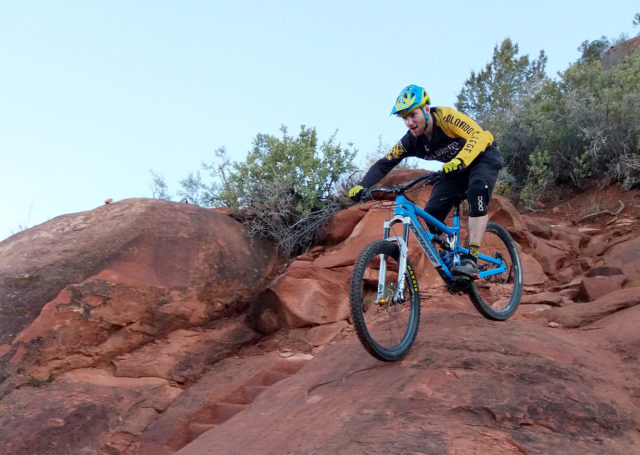
This was especially apparent when comparing the DBX 3.0 Enduro back to back with a MIPS-equipped helmet on a hot day. While many of us have tolerated the MIPS greenhouse effect for the sake of protection, there’s no denying that putting an extra layer of plastic next your scalp doesn’t do you any favors in terms of breathability. On the other hand, Leatt’s turbines didn’t insulate my head appreciably, but intend to do the same job as MIPS. Again, I can’t (or won’t) do a back-to-back comparison of concussion prevention between the two systems, but on the assumption that the turbines and MIPS are essentially doing the same thing, Leatt’s system is certainly superior in terms of breathability and comfort.
For the times that I used the helmet in its full-face mode, I was impressed by how comfortable and “not a big deal” it was to wear. While the DBX 3.0 Enduro is a breathable, albeit substantial half-shell, it feels like an extremely minimal and comfortable full-face. Even in hot weather, the chin bar doesn’t feel like it was adding much insulation, so the only real downside of the chin bar was finding a good place to stash it during a climb.
Bottom Line
The Leatt DBX 3.0 Enduro’s $240 price tag will likely be the hardest thing for many riders to accept, but if you’re truly planning on using the helmet as “two helmets in one,” you might be able to overlook it. If you do, you’ll equip yourself with a very well designed helmet that offers a lot in the way of versatility (just remember that the DBX 3.0 Enduro does not meet DH standards).
For full-on DH racing, DBX 3.0 Enduro wouldn’t keep me from just grabbing my DH helmet. However, I can think of plenty of scenarios where bigger risks are being taken, but a full-face would be too hard to haul out into the woods. If these scenarios sound familiar to you, or if you just want some additional protection on the descents, I’d give the DBX 3.0 Enduro a look. And when some rides don’t require the extra protection, run it without the chin bar, because it makes a damn good half-shell too.
